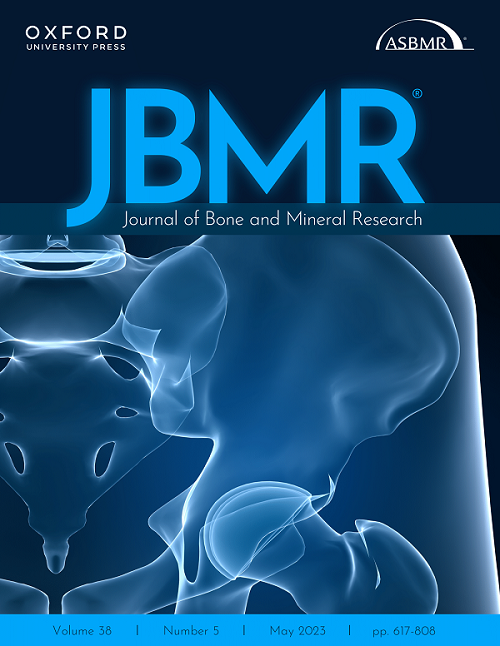Roy B. Choi, April M. Hoggatt, Daniel J. Horan, Emily Z. Rogers, Gabriela G. Loots, Alexander G. Robling
下载PDF
{"title":"硬化蛋白缺失时Sostdc1抑制增强小鼠皮质骨的合成代谢作用","authors":"Roy B. Choi, April M. Hoggatt, Daniel J. Horan, Emily Z. Rogers, Gabriela G. Loots, Alexander G. Robling","doi":"10.1002/jbmr.4798","DOIUrl":null,"url":null,"abstract":"<p>The development of Wnt-based osteoanabolic agents has progressed rapidly in recent years, given the potent effects of Wnt modulation on bone homeostasis. Simultaneous pharmacologic inhibition of the Wnt antagonists sclerostin and Dkk1 can be optimized to create potentiated effects in the cancellous bone compartment. We looked for other candidates that might be co-inhibited along with sclerostin to potentiate the effects in the cortical compartment. Sostdc1 (Wise), like sclerostin and Dkk1, also binds and inhibits Lrp5/6 coreceptors to impair canonical Wnt signaling, but Sostdc1 has greater effects in the cortical bone. To test this concept, we deleted Sostdc1 and Sost from mice and measured the skeletal effects in cortical and cancellous compartments individually. Sost deletion alone produced high bone mass in all compartments, whereas Sostdc1 deletion alone had no measurable effects on either envelope. Mice with codeletion of Sostdc1 and Sost had high bone mass and increased cortical properties (bone mass, formation rates, mechanical properties), but only among males. Combined administration of sclerostin antibody and Sostdc1 antibody in wild-type female mice produced potentiation of cortical bone gain despite no effect of Sostdc1 antibody alone. In conclusion, Sostdc1 inhibition/deletion can work in concert with sclerostin deficiency to improve cortical bone properties. © 2023 The Authors. <i>Journal of Bone and Mineral Research</i> published by Wiley Periodicals LLC on behalf of American Society for Bone and Mineral Research (ASBMR).</p>","PeriodicalId":185,"journal":{"name":"Journal of Bone and Mineral Research","volume":"38 5","pages":"765-774"},"PeriodicalIF":5.1000,"publicationDate":"2023-03-09","publicationTypes":"Journal Article","fieldsOfStudy":null,"isOpenAccess":false,"openAccessPdf":"https://onlinelibrary.wiley.com/doi/epdf/10.1002/jbmr.4798","citationCount":"1","resultStr":"{\"title\":\"Sostdc1 Suppression in the Absence of Sclerostin Potentiates Anabolic Action of Cortical Bone in Mice\",\"authors\":\"Roy B. Choi, April M. Hoggatt, Daniel J. Horan, Emily Z. Rogers, Gabriela G. Loots, Alexander G. Robling\",\"doi\":\"10.1002/jbmr.4798\",\"DOIUrl\":null,\"url\":null,\"abstract\":\"<p>The development of Wnt-based osteoanabolic agents has progressed rapidly in recent years, given the potent effects of Wnt modulation on bone homeostasis. Simultaneous pharmacologic inhibition of the Wnt antagonists sclerostin and Dkk1 can be optimized to create potentiated effects in the cancellous bone compartment. We looked for other candidates that might be co-inhibited along with sclerostin to potentiate the effects in the cortical compartment. Sostdc1 (Wise), like sclerostin and Dkk1, also binds and inhibits Lrp5/6 coreceptors to impair canonical Wnt signaling, but Sostdc1 has greater effects in the cortical bone. To test this concept, we deleted Sostdc1 and Sost from mice and measured the skeletal effects in cortical and cancellous compartments individually. Sost deletion alone produced high bone mass in all compartments, whereas Sostdc1 deletion alone had no measurable effects on either envelope. Mice with codeletion of Sostdc1 and Sost had high bone mass and increased cortical properties (bone mass, formation rates, mechanical properties), but only among males. Combined administration of sclerostin antibody and Sostdc1 antibody in wild-type female mice produced potentiation of cortical bone gain despite no effect of Sostdc1 antibody alone. In conclusion, Sostdc1 inhibition/deletion can work in concert with sclerostin deficiency to improve cortical bone properties. © 2023 The Authors. <i>Journal of Bone and Mineral Research</i> published by Wiley Periodicals LLC on behalf of American Society for Bone and Mineral Research (ASBMR).</p>\",\"PeriodicalId\":185,\"journal\":{\"name\":\"Journal of Bone and Mineral Research\",\"volume\":\"38 5\",\"pages\":\"765-774\"},\"PeriodicalIF\":5.1000,\"publicationDate\":\"2023-03-09\",\"publicationTypes\":\"Journal Article\",\"fieldsOfStudy\":null,\"isOpenAccess\":false,\"openAccessPdf\":\"https://onlinelibrary.wiley.com/doi/epdf/10.1002/jbmr.4798\",\"citationCount\":\"1\",\"resultStr\":null,\"platform\":\"Semanticscholar\",\"paperid\":null,\"PeriodicalName\":\"Journal of Bone and Mineral Research\",\"FirstCategoryId\":\"3\",\"ListUrlMain\":\"https://onlinelibrary.wiley.com/doi/10.1002/jbmr.4798\",\"RegionNum\":1,\"RegionCategory\":\"医学\",\"ArticlePicture\":[],\"TitleCN\":null,\"AbstractTextCN\":null,\"PMCID\":null,\"EPubDate\":\"\",\"PubModel\":\"\",\"JCR\":\"Q1\",\"JCRName\":\"ENDOCRINOLOGY & METABOLISM\",\"Score\":null,\"Total\":0}","platform":"Semanticscholar","paperid":null,"PeriodicalName":"Journal of Bone and Mineral Research","FirstCategoryId":"3","ListUrlMain":"https://onlinelibrary.wiley.com/doi/10.1002/jbmr.4798","RegionNum":1,"RegionCategory":"医学","ArticlePicture":[],"TitleCN":null,"AbstractTextCN":null,"PMCID":null,"EPubDate":"","PubModel":"","JCR":"Q1","JCRName":"ENDOCRINOLOGY & METABOLISM","Score":null,"Total":0}
引用次数: 1
引用
批量引用

 求助内容:
求助内容: 应助结果提醒方式:
应助结果提醒方式:


